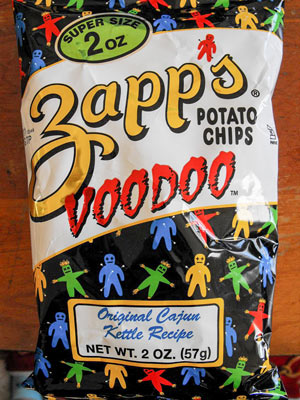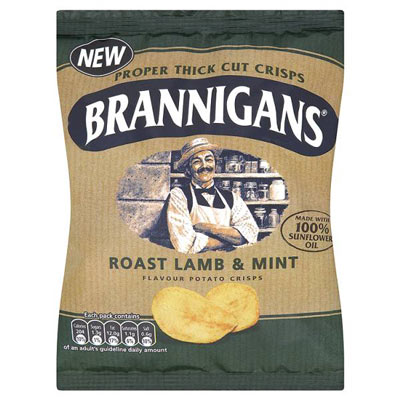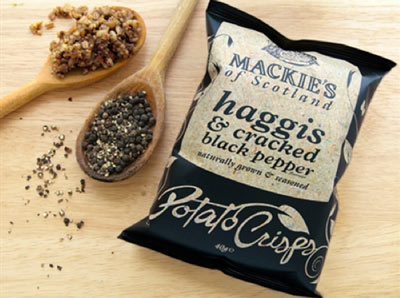Occasional Miscellany: Strange bedfellows & Scottish tradition in an unexpected guise.
In the United States, varieties of flavored potato chips other than those longtime stalwarts, barbecue and vinegar with salt, have proliferated in recent years. In an effort to cash in on the food of the rural south, for example, Lay’s has marketed chicken & waffle potato chips. Herr’s potato chips infused with Old Bay seasoning make more sense and they are outstanding.
Whatever your opinion about the health effects of potato chips--at least one nutritionist has pronounced them the perfect junk food in their caloric and addictive fusion of salt, fat, crunch and overprocessed carbohydrate--the phenomenon of the flavored chip has become inescapable.
As it happens, the United States historically has been a global laggard when it comes to flavoring potato chips. An exception is Zapp’s from New Orleans, which is fitting because New Orleans is an outlier in pretty much any cultural context imaginable. It appears that Utz has purchased Zapp’s, but the new owner has had the common sense to leave its acquisition unaltered, at least for now.
Zapp’s chips include very good greenish “Cajun Dill Gatortators” which contain no alligator and even though dill has no association with Cajun food; “Hotter ‘N Hot Jalapeno” chips; “Sweet Creole Onion” chips, a description that is fair enough in terms of traditional Louisiana produce; Voodoo; Voodoo Heat; and, of course, Mardi Gras ‘special edition’ Gatortator chips.
The Voodoo chips are akin to Old Bay chips, infused with a Louisiana seasoning mix, “as the result of an accident.” According to the Zapp’s website, “[a]n employee was moving a pallet of spices off the top shelf and dropped it. While cleaning up, someone stuck their [sic] finger into the mixture of about 5 flavors and pronounced it great.”

The avatar of Zapp flavorings, however, has to be the “Spicy Cajun Crawtator.” The somewhat confusing and decidedly ungrammatical description of the Crawtator on the website claims: “The taste of a Cajun boiled seafood feast that goes crunch and your mouth goes wow. Zapp’s was the first Cajun flavored anything [?] and is still our #1 seller!
Zapp’s offers scant insight into the formula that supposedly replicates the flavors of crawfish, corn, sausage, shrimp and potato. Other than garlic and onion powders and paprika, the elements intended to replicate a crawfish boil remain under wraps, described at the ingredient only in the most secretive terms as “spices” and “natural and artificial flavors.” Perhaps the artifice mimics the crustacean flavors.
Romania and Japan, otherwise unconnected cultures, share a talent for creativity in flavoring potato chips, if in different ways. Romanian flavorings include ‘pickles,’ cheeseburger and “Grilled Minced Beef Rolls.” The Japanese, no laggards in the field of culinary bizarredom, outdo their central European rivals with “blueberry (natural and cool)” and octopus. For a mercifully limited time, Pringles sold white chocolate peppermint as well as cinnamon and sugar potato chips, or what pass for potato chips in the toxic cleanup site that is a Pringles product.
For sheer and perverse virtuosity in selecting flavors for potato chips, however, the British brook no rival. Nobody need bother assembling all the constituents of traditional Sunday lunch, the roast and its trimmings, when anybody can open a bag of crisps in the guise of “Sunday Best Roast Chicken,” “Sweet Cured Ham & Pickle,” “Roast Lamb & Mint” or “Roast Ox.”

You could accompany your roast with pickled onion or Ketchup crisps, or crisps laced with Henderson’s Yorkshire Sauce, a sort of vegan Worcestershire that tastes good anyway. If you lacked the foresight to buy “Roast Beef & Spitfire Ale” crisps you could ‘wash down’ your unroasts with Guinness crisps.
Acolytes of Elizabeth David who disdain traditional British food, and everybody living in Islington or Notting Hill, could devour Firecracker Lobster crisps, oyster & lobster crisps or pesto crisps while fogeys could comfort themselves with pork sausage & English mustard crisps.
In 2008, Walkers, a legacy rather than artisanal producer, held a public competition to choose the ‘best’ of six concoctions that, for better and worse, also reflect the cosmopolitan cast of contemporary British cuisine: “Chilli & Chocolate,” “Crispy Duck & Hoisin,” fish & chips, onion bhaji, “Cajun Squirrel” and “Builder’s Breakfast.” To the shock of the judges, the squirrel lost out to the builder.
It must have required most of the periodic table to replicate the taste of a breakfast that traditionally may include bacon, beans, egg, kidney, mushrooms, black and white puddings, sausage and buttered toast with marmalade. Perhaps the cost was prohibitive: Walkers discontinued the breakfast crisps after two years, although Tayto’s, a British competitor, soldiered on with its Ulster Fry crisps which would be essentially the same thing.
We had not encountered a relative Scottish newcomer until earlier this year, at a Celtic specialty shop in Portsmouth, New Hampshire. It came as a surprise but on reflection is an obvious choice, for the chips are flavored with haggis. That sounds ambitious, because haggis like a big breakfast is not a single substance such as vinegar or cheese, two longstanding stalwarts on the flavored crisp market in the UK. The constituents of traditional haggis include sheep’s pluck (heart, kidney, lung, liver and windpipe) mixed with oatmeal, onion, black pepper and various seasonings. Whisky, while not traditional, now finds its way into some haggis as well.
Our haggis chips come from Mackie’s of Scotland, who are sticklers when it comes to Scots foodways, because it turns out they also make chips flavored with haggis and whisky. Other offerings include “flame grilled Aberdeen Angus,” “crispy bacon,” mature Cheddar & onion, roast ham, prawn cocktail, and venison & cranberry along with the somewhat less Scottish Scotch bonnet, “caramelized red onion” and “tangy tomato.”
We should respect Mackie’s for refusing to resort to chemistry, not too much of it anyway, although the way Mackie’s flavors its chips with haggis is not entirely intuitive. The “haggis and cracked black pepper seasoning” consists of “sugar, natural pork flavouring, yeast extract, salt, pepper, rusk, oatmeal, onion powder, spices, flavorings [sic; it is spelled different the second time on the bag], citric acid, vegetable extracts”.

Haggis is most frequently made with lamb or mutton, and also may be based on beef or venison, but is not associated with pork. Perhaps Mackie’s simply wanted something meaty and pork, they thought, provided the best tone for their chips. But why the rusk? On potato chips? Potatoes themselves are cheap so Mackie’s has no need for filler; maybe the rusk bonds the flavor of the seasoning to the fried chip like some sort of alchemical culinary polymer.
However they got that way, the haggis chips are good, evocative of the prince of puddings rather than bludgeony, a pleasant consort to good British beer or an American variation on IPA.
Then again potato chips flavored like potato taste pretty good too.

